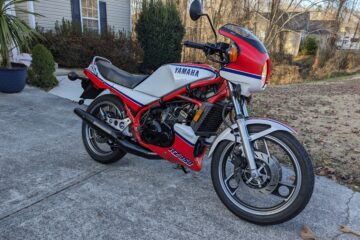Here is another Motorcycle Survey done by JD Power assessing the satisfaction of new motorcycle buyers. The numbers are good and trend upward suggesting that the quality of the bikes and service is getting better each year. But there is one trend that is not good- the average age of buyers is going up each year and now stands at 47. This is a real problem if the industry can’t attract younger buyers. My theory on this is that the price of new bikes is simply too high for younger buyers to afford. I also think that the baby boomers are the driving force behind sales since they are the ones who can now afford the bike they always wanted but couldn’t get earlier in life. So one big push for the manufacturers needs to be making desirable, lower cost bikes. Lets face it, most 25-30 year old guys (and girls) are not in a position to buy a $10-15,000.00 bike. That is the price of an economy car or a really nice used car. Once that age group starts having kids, the economic pressure gets even more intense. What we need is more bikes like Suzuki’s SV650, which is in the 6000.00 price range- and really needs to be even cheaper. Being in the used bike business, I have found that 5000.00 is a magic number. Once the price get higher than that, the number of prospective customers drops drastically. So I do wonder if Japan could take all that technology and apply it to making motorcycling more affordable. Harley and the Europeans need to do likewise if they have any chance of increasing sales- or keeping the sales level they already have. With the economy as it is, that will be a huge challenge.
WESTLAKE VILLAGE, Calif.: 17 December 2008 — Overall satisfaction with the motorcycle ownership experience has increased for a sixth consecutive year to a record-high level, according to the J.D. Power and Associates 2008 Motorcycle Competitive Information StudySM released today.
Now in its 11th year, the study measures owner satisfaction with new motorcycles by examining five major components of the overall ownership experience: product; quality; cost of ownership; sales; and service.
Overall motorcycle ownership satisfaction averages 814 (based on a 1,000-point scale) in 2008, up 5 points from 2007. While all five components driving satisfaction improve in 2008, the most notable increases occur in the areas of cost of ownership and product quality.
Overall, satisfaction with cost of ownership has increased steadily over time. In 2008, satisfaction with cost of ownership improves by 11 points from 2007 to an average of 707. In addition, 18 percent of owners in 2008 report that the cost of owning their motorcycles is “outstanding” (a rating of 10 on a 10-point scale), compared with only 10 percent of customers in 2005 who indicated the same. Furthermore, 30 percent of motorcycle owners in 2008 indicate that the value they received for the price paid is “outstanding,” compared with 21 percent in 2005.
The study finds that product quality has improved in 2008, compared with 2007, primarily due to a decrease in owner-reported problems. The overall number of problems reported averages 152 problems per 100 vehicles (PP100)—down 8 PP100 from 2007. In addition, the number of owners who report having a problem-free experience with their motorcycle averages 42 percent in 2008, an improvement of 3 percentage points, compared with 2007.
“Despite the fact that owners report paying 14 percent more for their motorcycles this year, they are also more satisfied with the value received for the money spent,” said Tim Fox, research manager of the powersports practice at J.D. Power and Associates. “There are several motorcycle models with a higher price point that owners have indicated are a particularly good value for the money. This demonstrates that if you make a superior product, consumers are willing to pay a higher price for it because they believe it to be an excellent value.”
The study also finds that the industry continues to struggle with attracting younger, first-time motorcycle buyers.
“Since 2001, the average age of motorcycle owners has increased from 40 to 47 years,” said Fox. “This indicates that the current population of motorcycle buyers is aging, and a large proportion of these owners are likely to soon exit the market. Because first-time motorcycle buyers comprise 22 percent of all new motorcycle purchases—a figure has remained relatively flat since 2001—it is critical for manufacturers to focus on attracting first-time and younger buyers—primarily those in the Gen X and Y demographics—in order to ensure continued growth in this market.”
The study also includes the following findings:
* Among motorcycle owners who visit a dealer for repair work, 79 percent report that the repair was performed correctly the first time—an increase of four percentage points from 2007.
* The two problems that have the greatest negative impact on overall product satisfaction are rough paint and engines that overheat. Other problems that have a particularly strong impact on satisfaction include gearshift issues, lacking power, and the ride being too stiff or too soft.
* During the past seven years, satisfaction with the engine and transmission has shown the greatest improvement among product-related aspects.
The 2008 Motorcycle Competitive Information Study includes responses from 7,334 owners who purchased new on-road or dual-sport motorcycles between September 2007 and May 2008. Owners were surveyed in September and October 2008.



0 Comments